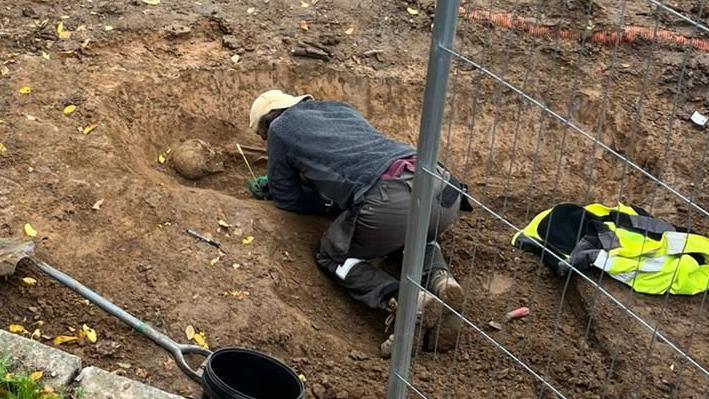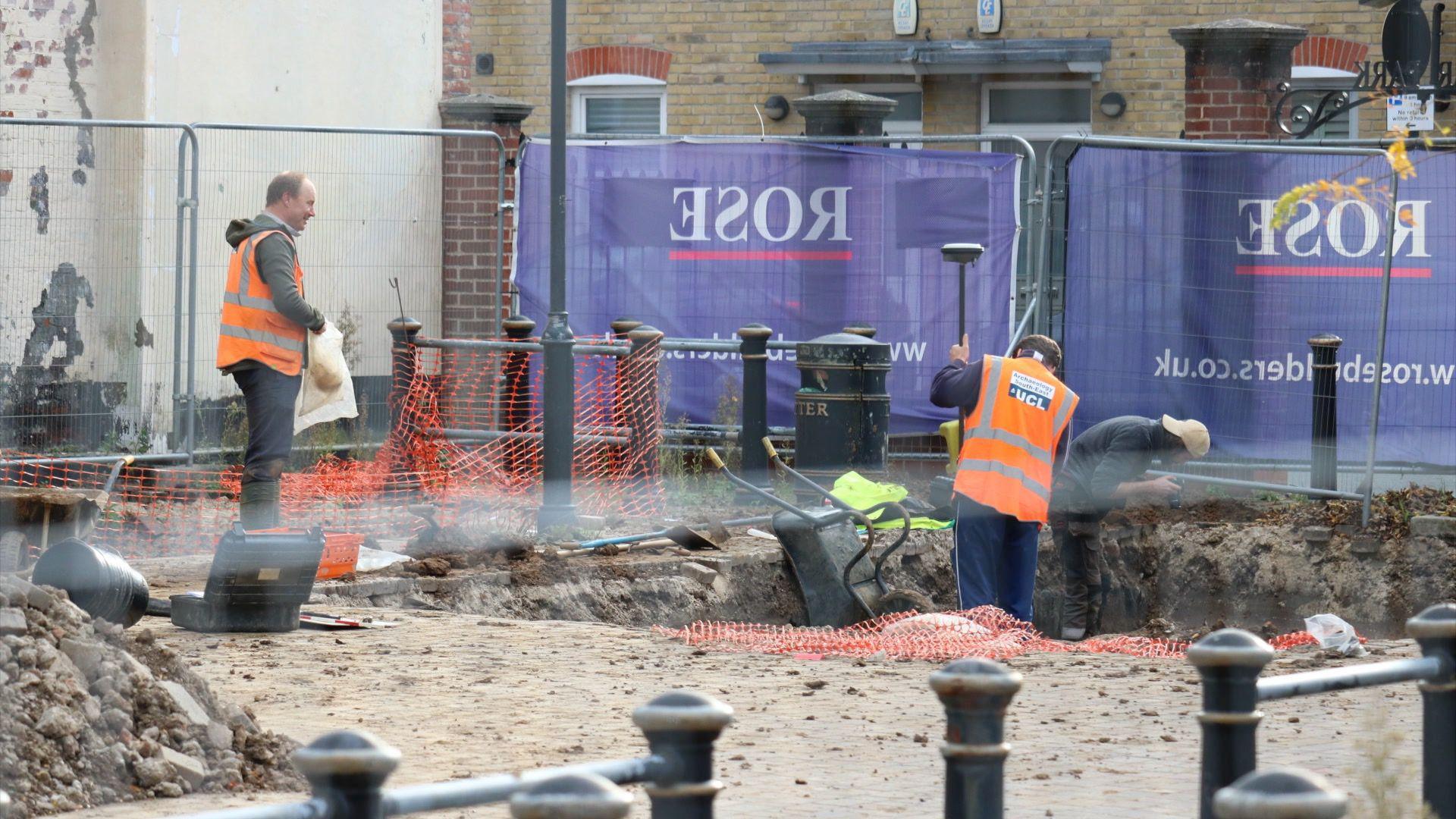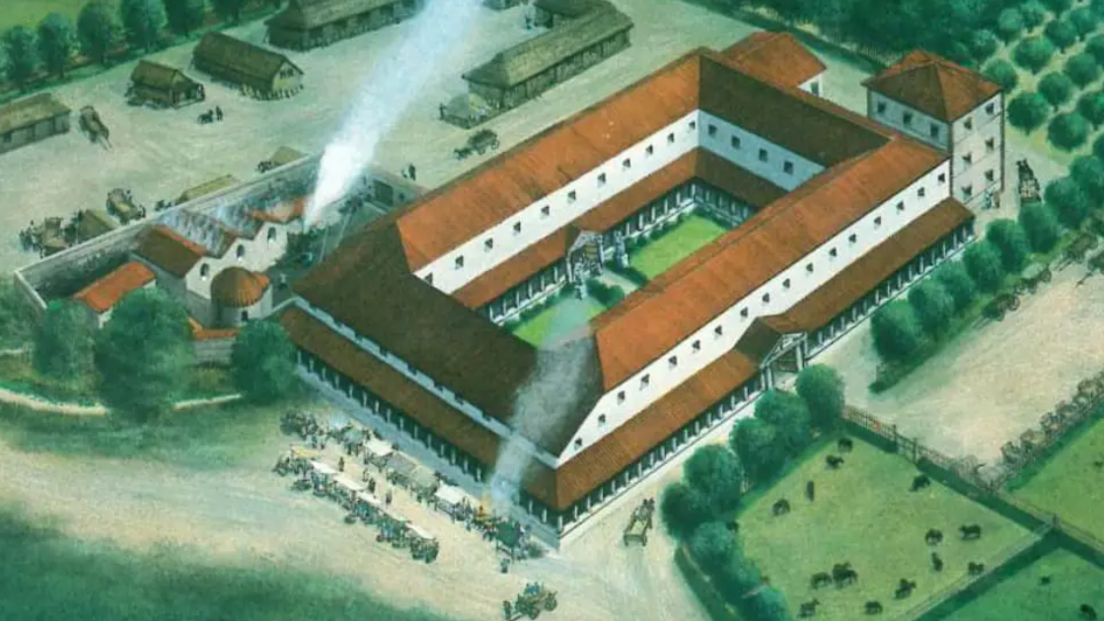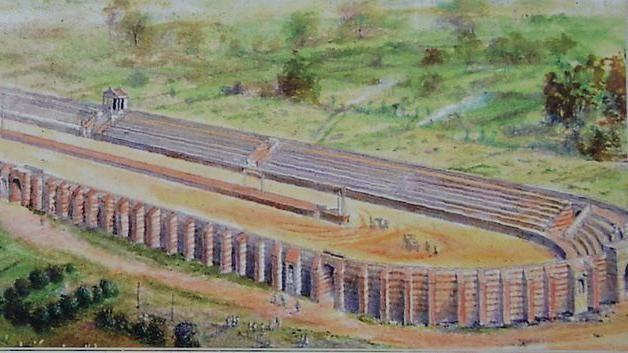What does Roman skeletons find mean for Chelmsford?

One of the skeletons was said to have been buried with a copper alloy crossbow brooch at the shoulder
- Published
The discovery of the graves of three skeletons underneath a car park has sparked a conversation about who they were and in what period they might have been buried.
It is believed the remains found in Chelmsford, Essex, this month dated back to the Roman era, with one potentially belonging to a Roman official or army officer.
This is not the first time the city has made headlines for its Roman links, after the discovery of the small market town of Caesaromagus, which was located near the recent excavation site.
Ben Paites, 34, senior collections and learning curator at Colchester Museums, said the bodies were found on what was once an old Roman road.
How were three skeletons discovered?

Dr Nick Cooke says the excavations acts as new evidence about the extent of Roman Chelmsford
Three Roman skeletons were uncovered at Moulsham Street car park in Chelmsford, Essex, which is being redeveloped into affordable homes.
Archaeologists from Archaeology South East have been excavating the site in advance of the redevelopment and said the remains uncovered were believed to date back to the late Roman period.
Tetra Tech, which coordinated the archaeological work on site, said the remains were in a "fairly poor condition" and they had been removed for analysis and would be taken to a museum.
Dr Nick Cooke, an archaeologist at RPS Tetra Tech, said: "The excavations have given us important new evidence about the extent of Roman Chelmsford, and in particular the Roman cemetery known to flank Moulsham Street.
"While we weren't expecting to find graves, previous trial trenching on the site did unearth a disturbed skill, so it was always a possibility."
Mr Paites said: "It is exciting when new discoveries have been found, but the likelihood is there won't be more information.
"Most of the time, we don't learn more about the people buried."
Mr Paites studied about the Romans while he was at university but said his interest in the era first sparked while learning Latin at school.
The Roman-expert also said it was common for police to be called when human remains were found, but the skeletons were likely to have been buried with items that would have identified them to be from that time.
It said it was believed the burial could be of a Roman official or Army officer, as one of the skeletons was buried with a copper alloy crossbow brooch at the shoulder, suggesting it was worn with a cloak and a belt buckle.
It is likely that the remains are going to be put up in a museum or to be reburied at a different site.
What Roman links does Chelmsford have?

Artist impression of Roman mansion and bath house
Chelmsford City Council said the small Roman market town of Caesaromagus laid to the south of the River Can.
It followed the line of the main Roman road linking London to Chelmsford and Colchester, created to the north of Moulsham Street.
The town was founded about the time of the Boudiccan uprising in 61 CE as a military road station.
It became derelict and remained so until Norman times when the river crossing was re-established in 1100 and a new town was founded north of the river in 1199.
Previous excavations off Moulsham Street and Hall Street revealed narrow, thatched timber houses which once lined the Roman street.
A number of burials had also been found further down Moulsham Street at Godfreys Mews and in Rothesay Avenue, the council said.
Digs between Mildmay Road and Roman Road have uncovered the heating system of the Roman baths.
Have there been other finds in the city?

The Great Baddow Hoard was an exceptional find of national importance, says the museum
Earlier this year a "one-of-a-kind" cache of 933 Iron Age gold coins went on permanent display close to where it was discovered.
The Great Baddow Hoard, which was rediscovered in 2020, was a "nationally significant" find because it was Britain's largest recorded Iron Age gold coin hoard, according to experts.
It was acquired by the Museum of Chelmsford following a £250,000 National Lottery Heritage Fund grant.
Curator Claire Willetts previously told the BBC it "could have been intended as a tribute payment to Roman general Julius Caesar".
Chelmsford City Council said previous excavations in other areas had revealed decorated medieval floor tiles, painted window glass, and a bone parchment pricker.
One hundred and forty-four Anglo-Saxon pennies were found near Braintree and were buried in 1066 year of the Battle of Hastings in 2024.
What other Roman links are there in Essex?

Remains of a chariot track were discovered in Colchester in 2004
The remains of the only known Roman Chariot racing track in Britain was found under army barracks that were being redeveloped in Colchester in 2004.
New homes were set to be built on the 209-acre (84-hectare) site and builders were preparing groundworks when the 2,000-year-old track was discovered.
The track was likely to have been in full use between the 2nd and 3rd Centuries, according to the Colchester Archaeological Trust.
It was probably constructed on the orders of Emperor Hadrian, who visited Britain in the year 122 CE.
The trust said the track was 450 metres (1,476ft) long and about 74 metres (243ft) wide, and would have had six tiers of seating for more than 8,000 spectators.
Get in touch
Do you have a story suggestion for Essex?
Follow Essex news on BBC Sounds, Facebook, external, Instagram, external and X, external.
Related topics
Related internet links
- Published6 November

- Published18 May

- Published14 May
